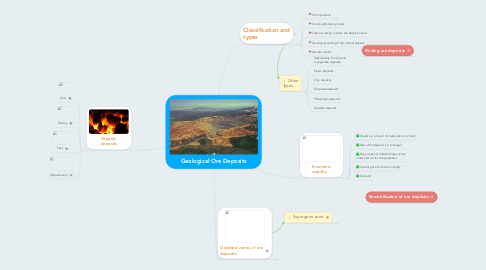
1. Organic deposits
1.1. Coal
1.2. Fireclay
1.3. Peat
1.4. Oil/petroleum
2. Classification and types
2.1. Of importance
2.1.1. Metallic deposits
2.1.2. Non-metallic deposits
2.1.3. Fossil fuel deposits
2.2. Commodity being mined
2.3. Tectonic setting in which the deposit occurs
2.4. Geological setting of the mineral deposit
2.5. Genetic model
2.5.1. Orthomagmatic deposits
2.5.1.1. Chromium
2.5.1.2. Titanium
2.5.1.3. Iron
2.5.1.4. Nickel
2.5.1.5. Copper
2.5.1.6. Platinum-group elements
2.5.1.7. Diamonds
2.5.2. Pneumatolytic and pegmatitic deposits
2.5.2.1. Tin
2.5.2.2. Rare-earth elements
2.5.2.3. Tantalum
2.5.2.4. Beryllium
2.5.2.5. Lithium
2.5.2.6. Molybdenum
2.5.2.7. Tungsten
2.5.3. Hydrothermal deposits
2.5.3.1. Lode gold deposits or archaean gold deposits
2.5.3.2. Epithermal deposits
2.5.3.2.1. Native gold and silver
2.5.3.2.2. Electrum
2.5.3.2.3. Acanthite and tetrahedrite
2.5.3.2.4. Silica occurring as quartz (most often forming comb-like aggregates), amethyst, opal, chalcedony and cristobalite
2.5.3.3. Replacement deposits in calcareous sequences
2.5.3.4. Base-metal vein deposits
2.5.3.5. Replacement skarn deposits
2.5.4. Volcanic or extrusive deposits
